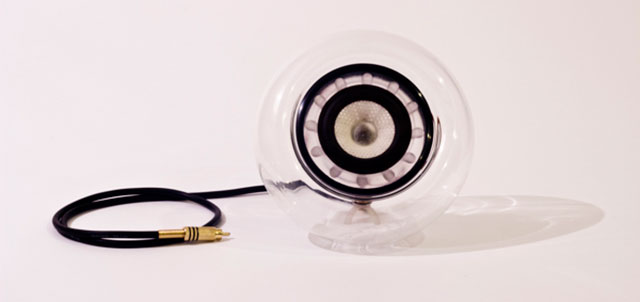New Zealander designer Simon Ellison has utilized multi-material 3D printing to craft speaker drivers. Working together with an audio engineer, the speaker was conceived to push the boundaries of traditional hi-fi sound design, exploring the ratios of digital material production. Simon supplied us with a unique sample of the speakers, attached at the end of this article.
For the technically minded: the additive combination-material print process results as a solid construction, allowing for complex and structurally intricate details.Taking just over nine hours to print and three hours to clean, the driver assembly was put together with the coil and magnet of a traditional driver, and wired to allow capabilities for a mono speaker. The complete component construction fits within a glass housing, fully equipped with an RCA terminal.
3DPI: Hi Simon, this is an adventurous project, have you designed speakers before?
SE: No I have never done any speaker design before.
3DPI: That’s even more impressive! How long did the design / prototype / print process roughly as a whole?
SE: Overall it took about 4 months. 3 months of design research and prototyping with the print taking about nine hours all up and 3 hours to clean.
3DPI: How many different 3D printed materials did you utilize?
SE: The speaker uses two different materials in four different variations. Using the Objet Connex 500 allows for digital materials within one print. Digital Materials are a ratio of the two materials that are run through the machine, in the case of my speaker I was using Vero Clear (a clear Resin like material) and Tango Black plus (a rubber material).
Using these two materials allowed me to print in full rubber, full resin and different variations in between these depending on the specific part that was required.
3DPI: How did you access Connex 500 that was used, do you own it?
SE: No I don’t. I am currently in my final year at Victoria University studying a Bachelor of Design Innovation and the recent purchase by the uni has allowed me to print with it.
3DPI: How did you find the 3D printing process?
SE: I think its great! 3D printing lets me manufacture prototypes whilst I’m still at university and the turnaround for a complete speaker is around nine hours. To make a speaker using traditional manufacturing would have taken me many days, liaising with many different companies. Whereas with the print I was able to model and research at uni then once I was ready to start the build process it was as simple as walking downstairs to our print technician.
3DPI: What were the alternative possible approaches without 3DP?
SE: The paper that I designed and made the speaker in was all about manufacturing using 3D printing, so I never really looked into using alternative methods.
From the start it was focused on using the Connex which would allow me to print one seamless speaker which was something we were pretty sure hadn’t been done before!
3DPI: If you’d have done anything different, what would it have been?
SE: If I was to do more with this I would look into the way that the speakers are printed and try to understand 3D printing further as a manufacturing technique. We are still learning the capabilities and limits of these machines and everyday people are pushing the limits further. Being the first speaker there are always refinements that could be made both aesthetically and in the assignment of materials.
3DPI: You have helped break new territory, I’m sure readers everywhere will recognise your bold ingenuity! Thanks for the chat Simon.
A sample of the output of Simon’s speakers:




